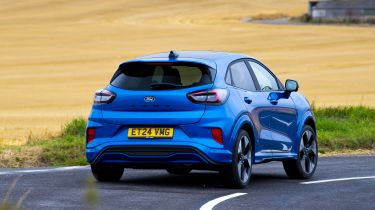Ford Puma review - MPG, running costs & CO2
Mild-hybrid technology ensures the Ford Puma has low running costs
The only powertrain available on the standard Puma is a 1.0-litre, three-cylinder mild-hybrid petrol engine with 124 or 153bhp. The mild-hybrid doesn't require plugging in, instead harvesting energy as the Puma decelerates and storing electricity in a compact lithium-ion battery pack. This powers a small generator that can give the petrol engine a boost as you accelerate, helping make its job easier, and saving fuel in the process. The engine has another trick too; it can shut down one of its three cylinders when full power isn’t required.
Ford has announced that an all-electric Ford Puma Gen-E will join the range later down the line, which should prove cheap to run, especially as a company car thanks to zero tailpipe emissions which will put it in the lowest Benefit-in-Kind (BiK) band. It’s expected it could be capable of a range of over 250 miles, which isn’t particularly class-leading, but if priced well it could prove competitive to cars like the Volvo EX30 and Peugeot E-2008.
Ford Puma MPG & CO2
The most fuel-efficient Ford Puma on sale is currently the 123bhp six-speed manual version of the 1.0-litre Ecoboost engine which can get up to 52.3mpg with CO2 emissions of 121g/km. Choosing the seven-speed automatic reduces fuel economy to an official 49.6mpg with CO2 emissions of 129g/km. Go for the 153bhp version with that same automatic gearbox and fuel economy doesn’t suffer at all, and CO2 emissions are actually less at 128g/km.
More reviews
The ST is now powered by a more potent version of the same mild-hybrid 1.0-litre, so even if you want the pokiest model, fuel economy is still good at 47.1mpg. CO2 emissions are slightly higher at 126g/km.
Thanks to the mild-hybrid tech, every standard petrol version of the Puma now costs the discounted rate in annual VED (road tax), which is £180.
Insurance groups
The Ford Puma 1.0-litre EcoBoost Titanium starts in insurance group 14, but upgrading to the 153bhp version increases this to group 17 out of 50. The SEAT Arona starts in lower single-digit groups, but higher trims will cost a similar amount to cover. The post-facelift Puma ST is yet to receive its insurance group rating.
Warranty
Ford has stuck with the three/60,000-mile warranty it has offered on most new cars for quite some time, which lags behind key rivals. Toyota now offers up to 10 years warranty cover, with the condition that you service the car at a dealer, and Hyundai offer a 5-year warranty/unlimited mileage warranty (taxis and reward for hire limited to 100,000 miles). Renault recently increased its warranty offering, so the Captur now gets five years/100,000 miles of cover.
Servicing
Ford still sells more cars in the UK than any other manufacturer and has a dealer network to match. Servicing locations should be convenient and Ford offers a servicing package that covers the first few years of maintenance, paid for either upfront or monthly.
Which Is Best?
Cheapest
- Name1.0 EcoBoost Hybrid mHEV Titanium 5dr
- Gearbox typeManual
- RRP£26,350
Most Economical
- Name1.0 EcoBoost Hybrid mHEV Titanium 5dr
- Gearbox typeManual
- RRP£26,350
Fastest
- Name1.0 EcoBoost Hybrid mHEV ST 5dr DCT
- Gearbox typeSemi-auto
- RRP£33,600









